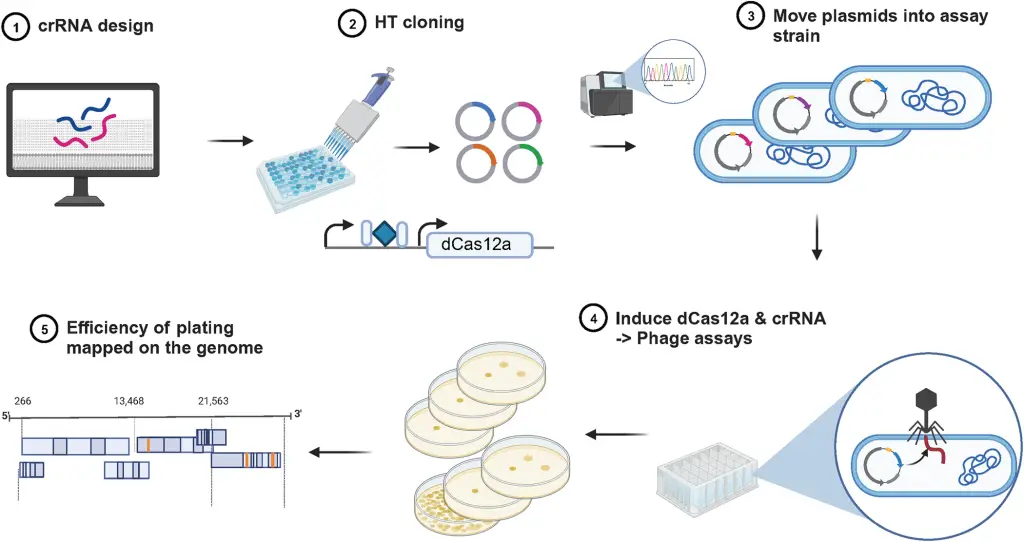The idea that living things may produce electricity is not new; in fact, it has long been known that many intricate processes within complex organisms depend on electricity.The complex interactions between electrical signals in our body control how our muscles contract and how we perceive our surroundings. Although this complex symphony of signals is normally conducted in complex life forms, new discoveries suggest that even more basic biological units such us viruses (bacteriophages) are capable of producing electricity. In an innovative work published in Advanced Materials, scientists from the University of California, Berkeley describe the fascinating property of pyroelectricity that a bioengineered virus exhibits in the presence of heat.
Understanding the Basics: What is M13 Phage?
In order to fully understand the remarkable powers of the M13 virus, let us take a closer look at some of its fascinating features as a bacteriophage. The M13 phage, which has a filament that is 880 nanometers long and thin and coiled, is symbiotically associated with the notorious Escherichia coli (E. coli) bacteria. This coexistence deviates significantly from the usual viral story because the M13 phage employs a subtle tactic. Instead of attacking its bacterial host, it skillfully inserts its genetic material, starting a symbiotic relationship that enables both to survive. When we take into account the distinctive spiraling protein structure of the M13 phage, this cooperative relationship becomes even more intriguing.
Apart from its intricate structure, the M13 phage has exceptional versatility and expandability. Its massively quick self-replication is one of its unique characteristics. Like identical chopsticks neatly put in a box, M13 phages can self-assemble thanks to their rapid multiplication, uniform shape, and evolutionary prowess. Because of this innate characteristic, the M13 virus is a perfect model system to investigate how structure and function interact to generate bioelectricity. The thin filament, graceful interaction with E. coli, and quick self-replication all add to the M13 phage’s complexity and increase its relevance in the fields of bioengineering and new materials.
Unveiling the Mystery: How M13 Phage Produces Electricity?
The complex spiral protein structure of the M13 virus is the key to its amazing capacity to generate electricity. Imagine a helix that envelops the virus in a gentle spiral staircase. A genetic modification that adds the amino acid glutamate transforms this structural marvel into a piezoelectric marvel in the M13 phage. Certain materials have a feature called piezoelectricity that enables the creation of an electrical charge in response to mechanical stress. This stress-induced charge sets off a delicate microscopic dance for the M13 phage, resulting in electrical sparks at every tiny squeeze, twist, or bend.
The groundbreaking research was first conducted by scientists at the University of California, Berkeley, who discovered the piezoelectric properties of the virus and enhanced its capacity to react not just to pressure but also to heat. Scientists were able to increase the virus’s pyroelectric potential by genetic engineering, which exposed a complex interaction of molecular elements and created opportunities for biosensing applications in the detection of dangerous compounds.
Building on Previous Discoveries: Piezoelectric and Pyroelectric Marvels
Building upon a decade-old revelation by researchers at the University of California, Berkeley, the M13 virus has been recognized for its piezoelectric properties, generating electricity in response to pressure. Expanding this knowledge, the researchers engineered the virus to exhibit pyroelectricity, responding to heat. By tweaking the genetic code and introducing a string of glutamate, the researchers amplified the virus’s pyroelectric potential, demonstrating its capacity to act as a biosensor for detecting hazardous chemicals, a significant leap from its earlier role as a normal temperate bacteriophage.
Exploring the Implications: How Can We Harness M13 Phage’s Electrical Prowess?
The electrifying capabilities of the M13 virus not only unravel a new dimension in advanced materials but also open the doors to bioengineering innovations. By manipulating its genetic code, scientists envision the creation of biological materials capable of generating electricity under pressure or temperature fluctuations. This revelation has profound implications for industries such as energy, electronics, and healthcare. Imagine pyroelectric sensors powered by M13 phages, ushering in a greener and more efficient era of energy harvesting.
Overcoming Obstacles: Challenges in Harnessing M13 Phage’s Electricity
While the potential is electrifying, challenges accompany the journey to harness the M13 virus’s power. Its piezoelectric and pyroelectric properties, though impressive, face limitations in high-power applications. Integrating organic materials into existing manufacturing processes presents technical complexities, demanding innovative solutions. Questions about the longevity of M13-based bio-batteries remain, urging researchers to explore practical applications and overcome obstacles on the path to a sustainable energy future.
As scientists continue to unlock the secrets of this tiny giant, we are drawing closer to a time when bioengineered materials will brighten our lives, reduce our influence on the environment, and usher in a new era of clean, green energy. Even if the journey may be challenging, the end point promises a thrilling and optimistic future.
If you enjoyed what you just read, there’s so much more waiting for you! 🌟 Don’t miss out on a single insight, update, or thought-provoking article from us. By subscribing to our newsletter, you’ll get a front-row seat subscribe here
Cover photo credit: Seung-Wuk Lee
More reading
- Lee BY, et al. Virus-based piezoelectric energy generation. Nat Nanotechnol. 2012;7(6):351-356.
- Lee, J. H., Lee, J. H., Xiao, J., Desai, M. S., Zhang, X., & Lee, S. W. (2019). Vertical self-assembly of polarized phage nanostructure for energy harvesting. Nano letters, 19(4), 2661-2667.
- Kim H, et al. Virus-based pyroelectricity. Adv Mater. 2023;35(46):e2305503.





Comments